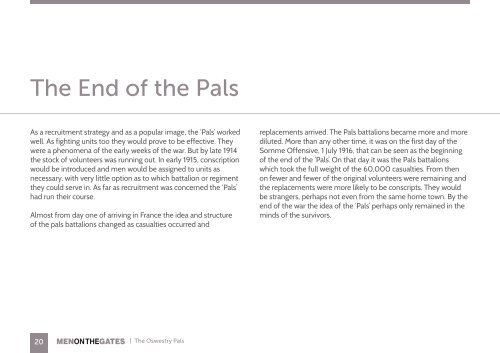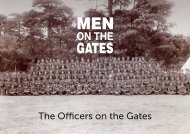MOTG_OP_Brochure_2018-01-19_V1_Proof
Create successful ePaper yourself
Turn your PDF publications into a flip-book with our unique Google optimized e-Paper software.
The End of the Pals<br />
As a recruitment strategy and as a popular image, the ‘Pals’ worked<br />
well. As fighting units too they would prove to be effective. They<br />
were a phenomena of the early weeks of the war. But by late <strong>19</strong>14<br />
the stock of volunteers was running out. In early <strong>19</strong>15, conscription<br />
would be introduced and men would be assigned to units as<br />
necessary, with very little option as to which battalion or regiment<br />
they could serve in. As far as recruitment was concerned the ‘Pals’<br />
had run their course.<br />
Almost from day one of arriving in France the idea and structure<br />
of the pals battalions changed as casualties occurred and<br />
replacements arrived. The Pals battalions became more and more<br />
diluted. More than any other time, it was on the first day of the<br />
Somme Offensive, 1 July <strong>19</strong>16, that can be seen as the beginning<br />
of the end of the ‘Pals’. On that day it was the Pals battalions<br />
which took the full weight of the 60,000 casualties. From then<br />
on fewer and fewer of the original volunteers were remaining and<br />
the replacements were more likely to be conscripts. They would<br />
be strangers, perhaps not even from the same home town. By the<br />
end of the war the idea of the ‘Pals’ perhaps only remained in the<br />
minds of the survivors.<br />
20<br />
| The Oswestry Pals








